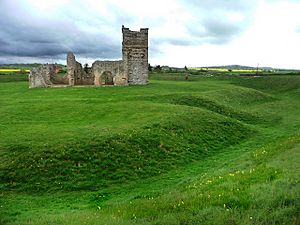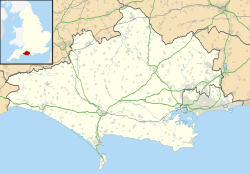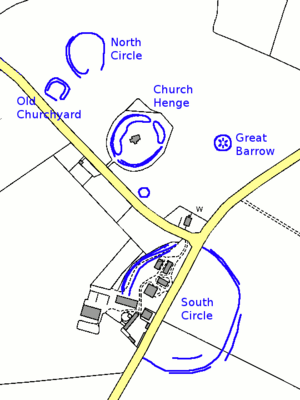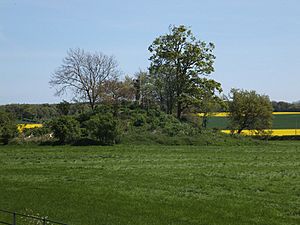Knowlton Circles facts for kids

Church Henge
|
|
| Location | Knowlton, Dorset |
|---|---|
| Coordinates | 50°53′31″N 1°58′03″W / 50.891972°N 1.967389°W |
| Type | Henge |
| History | |
| Periods | Neolithic |
| Site notes | |
| Ownership | English Heritage |
The Knowlton Circles (also called Knowlton Henges or Knowlton Rings) are a group of ancient sites in Knowlton, Dorset, England. These amazing places include large circular earthworks called henges, and many round barrows (ancient burial mounds). The most famous part is the henge that surrounds the old Knowlton Church.
Contents
What are the Knowlton Circles?
The Knowlton Circles are a collection of very old monuments from the Neolithic (New Stone Age) and Bronze Age periods. They are found close to the village of Knowlton. There are four main enclosed areas here. Three of them are typical henges: Church Henge, Knowlton North, and Knowlton South. The fourth is a squarish area called Old Churchyard.
Church Henge is the best preserved of these ancient sites. It even has the ruins of Knowlton Church inside it. Also nearby is a very large round barrow called Great Barrow, along with many other smaller burial mounds.
Church Henge: The Main Circle
Church Henge is the best preserved of the three henges at Knowlton. It is also known as the Central Circle. This site is an oval shape, surrounded by a ditch and a raised bank of earth. The oval measures about 106 metres long and 94 metres wide.
The ditch around it is about 10 metres wide and up to 1 metre deep. The outer banks are also 10 metres wide and stand up to 1.75 metres high. These banks are made of straight sections connected by rounded corners. There are three gaps in the bank, which might have been entrances.
The ruins of Knowlton Church stand right in the middle of this henge. This shows how the area changed from ancient pagan worship to Christian use. Evidence of early Christian activity was found in 1958. Archaeologists discovered an Anglo-Saxon burial ground east of Church Henge. They found sixteen graves dug into the chalk.
The oldest parts of the church were built in the 12th century. Later additions and changes were made in the 15th and 18th centuries. Sadly, the church roof fell in during the 18th century, and the church was then left empty.
Knowlton North: The Northern Henge
Knowlton North is a smaller henge located to the northwest of Church Henge. It is the northernmost henge in the Knowlton group. Most of this henge has been flattened by farming over the years.
However, you can still see its outline clearly from the air as cropmarks. These are patterns in crops that show buried features. It looks like an elongated oval, about 94 metres across. It had a ditch with an outer bank and a large entrance on its southeast side.
Knowlton South: The Largest Henge
Knowlton South is the largest of the henges at Knowlton. It is also the southernmost one. Parts of it still exist as earthworks, but farming has also damaged it. Some sections are best seen as cropmarks.
This huge henge is now cut in half by the road that goes from Cranborne to Wimborne. Some farm buildings also sit on its western side. The henge is about 250 metres across. It is defined by a ditch and an outer bank. The best-preserved part is on the northwest side. Here, the bank is 13 metres wide and about 1.2 metres high. The ditch is 15 metres wide and 1.5 metres deep. We don't know where the original entrance was, as it might be under the road or the farm buildings.
Old Churchyard: A Mystery Enclosure
Old Churchyard is an enclosed area whose original purpose is not fully known. It is located southwest of the North Circle. Farming has almost completely flattened it. However, it is still visible as a cropmark. It has a rounded square shape, about 60 metres across. It was surrounded by a low bank and an outer ditch.
Great Barrow: A Giant Burial Mound
Great Barrow is a very large round barrow. It was likely built in the Late Neolithic or Early Bronze Age. It is located east of Church Henge and has a clump of trees on top. This is the biggest barrow in all of Dorset.
The mound itself is 40 metres across and 6 metres high. It was surrounded by two circular ditches. Most of these ditches have been flattened by farming. The inner ditch was separated from the mound by a 5-metre flat area. The outer ditch was 10 metres wide, 1.5 metres deep, and about 120 metres across.
Knowlton Circles Barrow Group
There are at least 35 barrows known in the Knowlton Circles Barrow Group, including the Great Barrow. This area has one of the largest collections of round barrows in Dorset. Most of these barrows can only be seen as cropmarks. However, some are still visible as mounds southwest of the South Circle.
These barrows are grouped into three main areas: south and southwest of the South Circle, north of the South Circle and around Church Henge, and northeast of the henges. This large number of burial mounds suggests that the Knowlton Circles were a very important religious place long ago.




